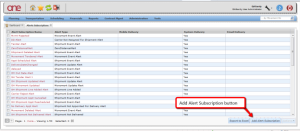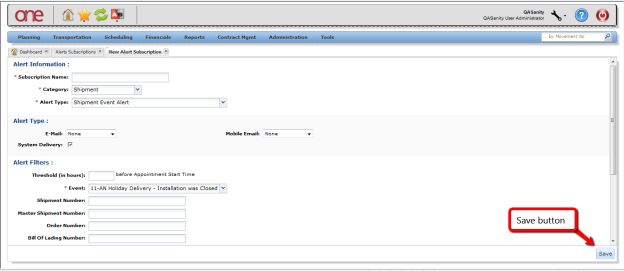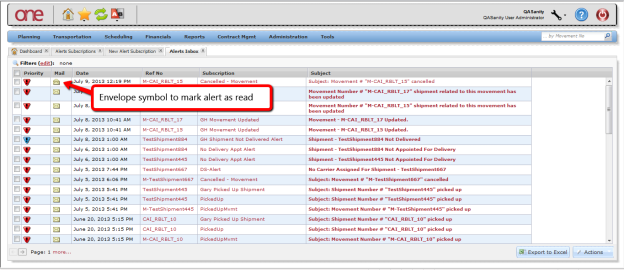Quick Guide to Subscribing to an Alert |
|
Introduction
This document provides a quick guide explaining how to subscribe to an Alert in the One Network System.
Throughout the day, many events occur within the One Network System. These events can trigger alerts that users may subscribe to, which keeps the user aware of certain things occurring or not occurring in the system. An event can be something such as a shipment being updated or a shipment not being delivered.
An alert can happen when a specific event occurs – these are referred to as event-based alerts. When a shipment is tendered would be an example of an event-based alert – the event is the tendering itself. An alert can also happen if an event does not occur within a specified time threshold - these are referred to as time-based alerts. An example of a time-based alert is using the Tender In Jeopardy alert type. You can subscribe to this alert and then specify a threshold time which would indicate the amount of time before the tender expires.
Subscribing to an
...
Alert
- Login to the One Network System.
- Select Tools -> Alerts Subscriptions:
...
The Alerts Subscriptions screen will be displayed with a list of your current alert subscriptions
.
To subscribe to a new alert, press the Add Alert Subscription button:
...
Note Note: To view or edit the details for an alert subscription, select the Alert Subscription Name link on the screen.
After pressing the Add Alert Subscription button, the New Alert Subscription screen will be displayed. This screen is divided into 3 sections: Alert Information, Alert Type, and Alert Filters. The Alert Filters section will change depending on what type of alert is selected in the Alert Information section
:
...
- Enter and select information in the Alert Information section of the screen:
Note: Fields marked with an asterisk symbol are required.
...
- Enter information in the Alert Filters section of the screen. This section allows you to specify certain filter criteria that needs to be met for this alert. For example, the Alert Filters section may include a Ship From Site field (depending on which alert type you selected). You could then specify a Ship From Site which means you would only get this alert for Shipments that contain this Ship From Site.
- Once all the information has been entered on the New Alert Subscription screen, press the Save button on the bottom of the screen. You will receive a message on the screen that the alert was successfully created.
- Once an alert is triggered, you will get an email message to the email address you specified on the alert plus the alert will be sent to the system if you selected this option.
- To view alerts sent to the system, select Tools -> Alert Inbox:
- The Alert Inbox screen will be displayed with a list of alerts that were sent to the system (Note – this would be for the alerts that you checked this option). The screen will list the date the alert was sent as well as the name of your alert. You can filter and search for specific alerts by selecting the "Filters (edit)" link, entering filter information and then pressing the Search link.
- On the Alert Inbox screen, you can mark an alert as "read" by selecting the envelope symbol for the alert. The envelope symbol changes to an open envelope to signify to you that you have already read and acknowledged this alert.
- To delete alert messages, select the checkboxes next to the alert messages and press the Actions button and select Delete Checked:
- Another way to view the alerts sent to the system is to add the Alert Summary portlet to your Dashboard. This Alert Summary portlet lists the name of the alert and the count or number of each of this alert – the count is displayed under the New Alerts column and the Total Alerts column. The New Alerts column will show you a count of the alerts you have not marked as "read" while the Total Alerts column will show you the total number of this alert (i.e. read and not read). You can select the count link for any alert to see the specifics for that alert.
...







